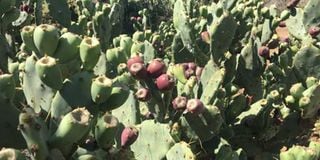Killer cactus

Opuntia ficus, an invasive cactus plant that is now considered the second biggest threat to the elephant population in northern Kenya after poaching. PHOTO | PAUL LETIWA
What you need to know:
- When elephants swallow it, glochids (small spines on the fruit) get lodged in their throats, stomachs or intestines. If they get stuck in the elephants’ mouths, the beasts develop abscesses and eventually starve to death because they can no longer eat,” he says.
- At the Naibunga Conservancy in Laikipia North, the cactus has already taken over about 17,000 acres. Mr Lekurtut says the arid conditions in the vast area have made it easy for the cactus to spread rapidly.
- When herders in the area slaughter a goat, they are puzzled by what eats up the animals’ intestines. He says many cattle, goats, sheep and donkeys have died due to complications caused by eating the cactus.
It is round and comes in different shades of green, covered with spines and hair-like prickles with yellow flowers and a few edible purple-reddish fruits.
These are the traits that biologists say ensure the survival of the Opuntia ficus, an invasive cactus plant that is now considered the second biggest threat to the elephant population in northern Kenya after poaching.
It’s not clear when the plant was introduced in Kenya, but Mzee Loitemu Letiktik, one of the elders in Labarishereki Village on the border of Isiolo and Laikipia counties, says the invasive species, which has taken over their grazing land, was introduced by white colonial farmers who settled in the area in the early 1950s.
Today, the cactus that has long been domesticated for use as a barrier nd liked for its juicy fruits is killing elephants in the two counties and making the environment inhospitable.
Mr Peter Lekurtut, the manager of Oldonyiro Conservancies in Isiolo North, says that in the past five months, six elephants died after eating the plant.
RIGHT CONDITIONS
“We do not have an accurate figure, but we can confirm that six elephants died after eating the plant. When elephants swallow it, glochids (small spines on the fruit) get lodged in their throats, stomachs or intestines. If they get stuck in the elephants’ mouths, the beasts develop abscesses and eventually starve to death because they can no longer eat,” he says.
At the Naibunga Conservancy in Laikipia North, the cactus has already taken over about 17,000 acres. Mr Lekurtut says the arid conditions in the vast area have made it easy for the cactus to spread rapidly.
“The plant has taken over our conservancy and is an irritant due to its spines. It prevents access to many areas in the ecosystems, displaces pastoral communities and causes injuries and infection to people, livestock and to other wild animals,” he says.
Mzee Letiktik says when herders in the area slaughter a goat, they are puzzled by what eats up the animals’ intestines. He says many cattle, goats, sheep and donkeys have died due to complications caused by eating the cactus. The situation is made worse by perennial droughts, which reduce food for livestock and wildlife, forcing them to turn to the prickly cactus.
Environmental experts say the eradication of any plant depends on factors such as the terrain, cost and availability of labour, severity of the infestation and presence of other invasive species.
But because of the limited resources in the arid and semi-arid lands in the north, controlling the fast spreading cactus is difficult. The possible methods include manual removal, chemical poisoning and biological control.
Elephants in Laikipia and Isiolo roam in big herds from arid landscapes to subtropical forests. They are widespread due to an extensive a community-based conservation strategy supported by a community led, non-governmental organisation, the Northern Rangelands Trust (NRT).
“We have tried manual control but the spines made this difficult,” says Charity Mukono, a communication officer at NRT.
Lewa Conservationist Ian Craig says the cactus is now found in northern Kenya and Tsavo National Park, both of which are suitable habitats for elephants.
“Currently, it’s invading at least two kilometres of habitat per year. It is a real serious threat not only to elephants, but to a wide range of wildlife and plant diversity, especially in the Isiolo, Laikipia and Samburu conservancies,” he says.
BIOLOGICAL CONTROL
Mr Lekurkut says that nomadic pastoralists contribute to the spread of the cactus since most of them use it as fencing to keep wild animals out of their homesteads.
Elephants too, which feed on the juicy fruits of the cactus, scatter fragments of the plants as they roam the grazing lands of Naibunga. When they eat the fruit, the seeds spread through their droppings.
A partnership of scientists from South Africa, conservationists, commercial ranchers and the local communities was formed to find ways of eradicating the cactus. They sought help from the Centre for Agricultural Biosciences International (CABI) — an international non-profit organisation which focuses on agriculture and the environment.
This gave birth to a biological control mechanism, whereby a cochineal, a sap-sucking insect, was introduced in the region; the method that is said to have been effective in controlling the same cactus species in the Kruger National Park in South Africa.
However, local pastoralists say the insect was released in a few areas and now the plant is spreading faster, especially in the mountains and valleys.
“We had hoped that the plant would vanish when the insect was introduced last year. It has destroyed the cactus in some areas but the plant is spreading fast in areas that it had not invaded like mountains and valleys,” says Mzee Letiktik





